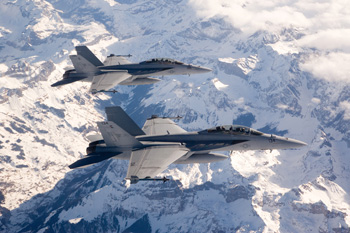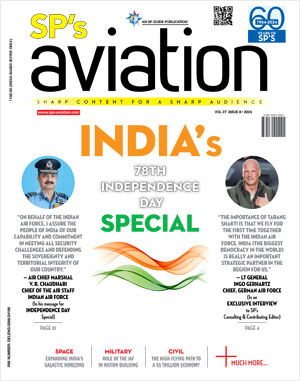INDIAN ARMED FORCES CHIEFS ON OUR RELENTLESS AND FOCUSED PUBLISHING EFFORTS

SP Guide Publications puts forth a well compiled articulation of issues, pursuits and accomplishments of the Indian Army, over the years

"Over the past 60 years, the growth of SP Guide Publications has mirrored the rising stature of Indian Navy. Its well-researched and informative magazines on Defence and Aerospace sector have served to shape an educated opinion of our military personnel, policy makers and the public alike. I wish SP's Publication team continued success, fair winds and following seas in all future endeavour!"

Since, its inception in 1964, SP Guide Publications has consistently demonstrated commitment to high-quality journalism in the aerospace and defence sectors, earning a well-deserved reputation as Asia's largest media house in this domain. I wish SP Guide Publications continued success in its pursuit of excellence.
Super Hornet or the Fighting Falcon
The requirement of the IAF is not for a light-weight fighter but for a medium to heavy weight combat aircraft capable of operating over long range without in-flight refuelling, preferably, powered by two engines for enhanced safety and should have a high payload carrying capability.
 |
By Air Marshal B.K. Pandey (Retd) Former Air Officer Commanding-in-Chief of Training Command, IAF |

A statement in mid-February this year by Manohar Parrikar, the Minister of Defence that “India will select one or two fighter aircraft which will be manufactured locally by a private company under Make in India initiative”, has led to a flurry of activity not only in the Indian aerospace industry in the private sector, but also amongst the leading manufacturers of combat aircraft in the world. However, behind-the-scene activity in this regard had begun much earlier, to be precise, soon after the tender for the 126 Rafale Medium Multi-Role Combat Aircraft (MMRCA) was cancelled in April last year. While the fresh initiative of that time by Prime Minister Narendra Modi to procure 36 Rafale jets in fly-away condition in a direct deal with the Government of France was welcome, the global aerospace industry was well aware that this would only partially alleviate the difficulty the Indian Air Force (IAF) is in with regards to the rapidly depleting strength of its fleet of combat aircraft. By 2020, the IAF will be short by as many as 300 aircraft in its combat fleet.
Saab of Sweden was perhaps the first in line with the offer to manufacture in India, the latest version of the JAS 39 Gripen which is claimed to be a fifth generation platform, with full transfer of technology. In competition followed two companies from the aerospace industry of the United States of America (USA) offering manufacture of combat aircraft in India under identical terms related to transfer of technology.
The nation has to make a choice between the F-16 IN Fighting Falcon and the F/A-18 E/F Super Hornet, the two readily available options.
In October last year, the Boeing company of the US had already revealed intentions of offering to build its latest version of F/A-18 Super Hornet in India if given an opportunity by the IAF. This first indication of this offer came from James McNerney, Chairman of Boeing, when he was addressing the gathering at an aerospace summit in India wherein he stated that he was looking forward to a partnership to “bring the best of Boeing to India and the Best of India to Boeing.” He also went on to say that India did need combat aircraft in fairly large numbers and that his company would be willing to manufacture a suitable fighter aircraft in India provided the order was large enough to justify the investment which undoubtedly, would be sizeable. While McNerney did not specify the aircraft that Boeing was prepared to offer, Chris Chadwick, President and CEO of Boeing Defense, Space and Security (at that time) went on to make a specific offer of the F/A-18 E/F Super Hornet for manufacture in India.
Not to be left behind, the US aerospace major Lockheed Martin Corporation has also come up with an offer to manufacture the F-16IN Fighting Falcon combat jets in India, once again under the Make in India scheme. This declaration was made to the media by Phil Shaw, CEO of Lockheed Martin India Private Ltd at the Singapore Airshow 2016. He also revealed that talks with the Indian authorities on this subject had been in progress for some time.
Brief History of Development
Development of the F-16 and the F-18 began in the US around the same time that is in the early 1970s. In a competition to develop a light-weight fighter aircraft for the US Air Force (USAF), General Dynamics (now Lockheed Martin Corporation) was awarded a contract to develop a single-engine fighter aircraft that was designated as the YF-16. Simultaneously, Northrop (later McDonnell Douglas) was contracted to develop a competing twin-engine combat aircraft dubbed as the YF-17. The prototype of the YF-16 undertook its maiden flight in December 1973 and the YF-17 took to the air in June 1974. After extensive evaluation, in January 1975, the YF-16 was chosen over the YF-17 in the light-weight fighter competition. Soon after, in the Navy Air Combat Fighter competition held on May 02, 1975, the US Navy selected the YF-17 as the basis for what would evolve as the McDonnell Douglas F/A-18 Hornet in single and twin-seat variants classified as C and D. The Boeing single-seat F/A-18E and the twin-seat F/A-18F Super Hornet multi-role combat aircraft are larger and more advanced derivatives of the F/A-18C and D Hornet and are capable of operating from aircraft carriers as well.
Combat Aircraft for the IAF
The versions of the two combat aircraft from the US aerospace industry that were competing for the contract for 126 medium multi-role combat aircraft (MMRCA) were the F-16 IN Fighting Falcon and the F/A-18 Super Hornet. Both the platforms were of the fourth plus generation. Unfortunately for the US aerospace industry, both the aircraft were eliminated in the Indian MMRCA competition as the Rafale from Dassault Aviation of France emerged as the winner. However, eight years after the Request for Proposal for the MMRCA was floated, the tender was cancelled leaving the IAF in serious difficulty with regard to its combat fleet. Problems for the IAF were compounded as the project to develop a Fifth Generation Fighter Aircraft (FGFA) jointly with Russia was and is not progressing at the desired pace. The need to explore alternatives for speedy induction of medium to heavy-weight combat aircraft in the numbers required has therefore become even more urgent.
Compared with the F-16IN Fighting Falcon, the F/A-18 F model of the Super Hornet is much larger in size, has a maximum takeoff weight that is over ten tonnes higher, has a 31 per cent higher combat radius and can carry weapon load that is significantly larger and of wider spectrum.
With the strengthening strategic partnership between India and the US, including the expanding relationship in the regime of defence, both driven partially by the increasing belligerence of China especially in the South China Sea, it would only be reasonable to expect that India would accord higher priority to defence deals with the US. India in now in a situation wherein it has to make a choice between the F-16 IN Fighting Falcon and the F/A-18 E/F Super Hornet, the two readily available options. To begin with, the requirement of the IAF is not for a light-weight fighter but for a medium to heavy weight combat aircraft capable of operating over long range without in-flight refuelling. The requirement of the IAF of a light-weight fighter is expected to be met through the indigenous Light Combat Aircraft (LCA) Tejas Mk I and IA initially and subsequently by Tejas Mk II. As for the requirement of a heavier platform, preferably, the aircraft should be powered by two engines for enhanced safety and should have a high payload carrying capability. It is also desirable that the aircraft be able carry a crew of two to provide for better efficiency when deployed on long range and long duration missions. Compared with the F-16IN Fighting Falcon, the F/A-18 F model of the Super Hornet is much larger in size, has a maximum takeoff weight that is over ten tonnes higher, has a 31 per cent higher combat radius and can carry weapon load that is significantly larger and of wider spectrum. As compared to the F-16 IN Fighting Falcon, the F/A-18 F is definitely more suitable for operating against targets in China.
One distinct advantage that would favour the selection of the F/A-18 E/F Super Hornet over the F-16 IN Fighting Falcon is the fact that the former would be eminently suitable for the Indian Navy as well.
One distinct advantage that would favour the selection of the F/A-18 E/F Super Hornet over the F-16 IN Fighting Falcon is the fact that the former would be eminently suitable for the Indian Navy as well. The Super Hornet has been and continues to be the mainstay of the aviation wing of the US Navy for several decades.
Advantages of Boeing’s Offer
It is understood that the offer from Boeing includes transfer of technology and substantial indigenous content. The IAF may thus have the option of selecting from a wide range of Israeli and French avionics made in India as well as from a range of weapon systems developed indigenously or procured from Europe or the US again through the Make in India route. These issues will have to be resolved through negotiations in the initial stages itself. Boeing has recently made inroads into the Indian aerospace industry through the two other programmes that are ongoing, namely the order for the 22 AH-64E Apache attack helicopters and 15 CH-47F Chinook heavy lift helicopters for which components are being made by companies in the private sector of the Indian aerospace industry. The US thus sees immense opportunities in India for its own aerospace industry.
Another major advantage of opting for the Super Hornet will be the GE-F414 engine. As Boeing has offered to set up the entire production line in India, it would be reasonable to assume that the GE F-414 engine, that powers the F/A-18 Super Hornet, will also be manufactured in India. This engine has also been selected to power the Tejas Mk 2 which is now under development. The IAF will be assured of the availability of life cycle support within India for the engines for both the fleets of the Super Hornet and the Tejas Mk 2. This would result in huge cost savings through economies of scale and also provide an opportunity to the Indian aerospace industry to acquire the capability to develop power plants for aircraft indigenously, something that it has not been able to achieve so far.
Perhaps the most compelling reason why India should not and will not opt for the F-16 IN Fighting Falcon is the decision by the US Government to continue to supply the latest versions of this platform to Pakistan.





